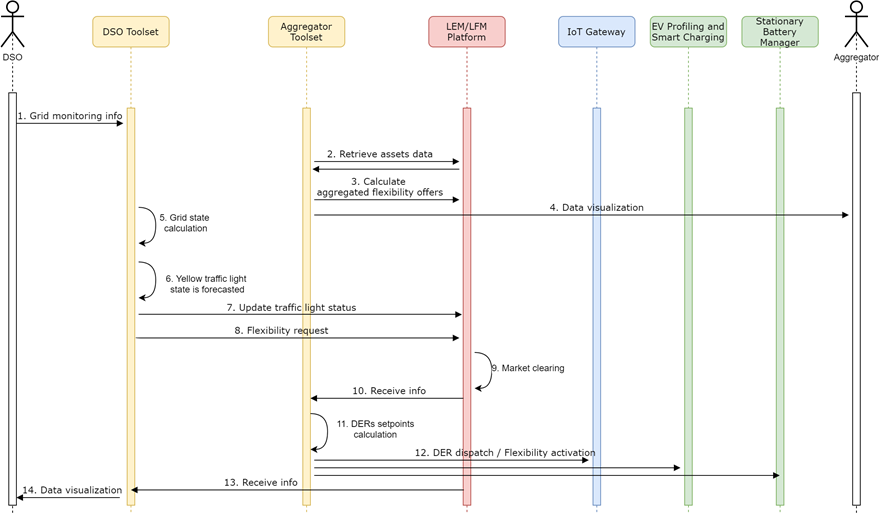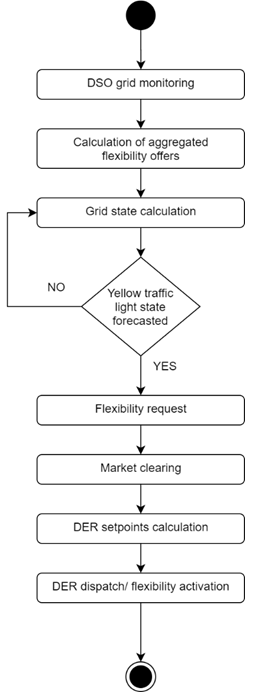UC-08
Congestion management by DSO through operation of LFM to increase DER penetration
1. Description of the Use Case
1.1. Name of the Use Case
| ID | Area /Domain(s)/Zone(s) | Name of the Use Case |
|---|
| 1 | / DER, Distribution /operation, market, | UC-08 |
1.2. Version Management
| Version No. | Date | Name of author(s) | Changes | Approval status |
|---|
| 1 | 2020-11-15T00:00:00 | CheckWatt,CERTH, | N/A | Final v1 |
1.3. Scope and Objectives of Use Case
| |
|---|
| Scope | Describes the process in which the DSO is acting as a single buyer of flexibility when grid is in yellow state, according to the traffic light concept, sets up and manages the LFM to attract the necessary resources to the LFM platform enabling congestion management. |
| Objective(s) | To provide flexibility to DSO through the Local Flexibiltiy Market according to DSO’s requirements. As a final result, foreseen congestion has been reduced or eliminated. |
| Related business case(s) | None |
1.4. Narrative of Use Case
Short description
DSO is a buyer of flexibility through the Local Flexibility Market, in order to manage a detected congestion
Complete description
This use case describes the process followed by the DSO when is acting as a flexibility buyer through LFM in order to manage congestion in a specific area. The DSO is the main actor involved and the initiator of this UC. The network is entered into the yellow state, therefore LFM is engaged, in order to activate required flexibility for solving the congestion. Important points are the following: 1. Grid modelling and identification of congestion management needs. Ideally the DSO acts as a single buyer in the LFM where necessary DER flexibility is purchased through automated Local Flexibility Market transactions.
2. DER mapping and recruitment through aggregator.
3. On-point remuneration model (tilt towards market-based rather than fixed rate) to assure attraction in the right spots in the grid.
| ID | Name | Description | Reference to mentioned use case objectives |
|---|
| 1 | Successful procurement of prosumer flexibility by the DSO | Sufficient amount of flexibility has been provided to DSO | None, |
1.6. Use case conditions
| Relation to other use cases |
|---|
|
| Level of depth |
| Prioritisation |
| Mandatory (High priority) |
| Generic, regional or national relation |
| Generic |
| Nature of the use cases |
| Technical |
| Further keywords for classification |
|
2. Diagrams of Use Case


3. Technical Details
3.1. Actors
| Actor Name | Actor Type | Actor Description | Further information specific to this Use Case |
|---|
| DSO | System operator | None | |
| Aggregator | Resource aggregator | None | |
| Market Operator | Market Operator | None | |
3.2. References
| No. | References Type | Reference | Status | Impact on Use Case | Organistaor / Organisation | Link |
|---|
4. Step by Step Analysis of Use Case
4.1. Overview of Scenarios
| No. | Scenario Name | Scenario Description | Primary Actor | Triggering Event | Pre-Condition | Post-Condition |
|---|
Notes
4.2. Steps – Scenarios
| Information exchanged ID | Name of Information | Description of Information Exchanged | Requirement |
|---|
6. Requirements (optional)
| Category Identifier | Name | Description | mRID |
|---|
| Req_ID | Req_Name | ‘Congestion management by DSO through operation of LFM to increase DER penetration’ | |
| Identifier | Name | Description | mRID |
|---|
7. Common Terms and Definitions
| Key | Value | Refers to Section |
|---|

